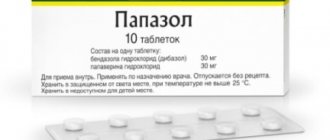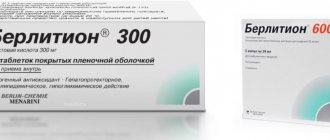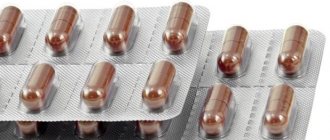Release form and composition
It is a synthetic drug whose active ingredient is amitriptyline hydrochloride.
Available in two dosage forms:
- Film-coated tablets, packaged in 50 pieces. Each tablet contains 25 mg of amitriptyline;
- Solution for injection 1% in ampoules of 2 ml. 1 ml of solution contains 10 mg of active substance. Ampoules are packed in cardboard packs of 5 or 10 pieces. There are 5 ampoules in a blister pack.
Over-the-counter analogues of the drug
In terms of their chemical structure, Imipramine and Clomipramine are analogues of Amitriptyline and representatives of the first generation of antidepressants, but they are sold only by prescription. It should be understood that antidepressants are serious medications that can cause significant harm to health, so very few of these drugs can be purchased without a doctor's prescription. Any structural analogue of Amitriptyline, which contains the same active substance, is dispensed with a medical prescription.
Among them:
- Amizol;
- Saroten Retard;
- Elivel;
- Tryptisol.
Today, Amitriptyline is the most effective antidepressant, which is included in the list of medications recommended by the World Health Organization. At the same time, its cost is extremely low, so this medicine is available to a wide range of buyers.
Indications for use of Amitriptyline
The drug is taken exclusively as prescribed by the attending physician. In addition, you should strictly adhere to the dosage indicated in the instructions for Amitriptyline.
There are the following indications for treatment with this drug:
- Anxiety and depression of any origin;
- Bulimic neurosis;
- Behavioral disorders, mixed emotional disorders and phobias;
- Psychogenic anorexia;
- Neurogenic pain syndromes;
- Migraine prevention;
- Pediatric enuresis, unless the patient has a hypotonic bladder.
Unlike many other antidepressants, Amitriptyline does not cause exacerbation of productive symptoms - delusions, hallucinations, etc.
special instructions
Before carrying out therapy, monitoring blood pressure levels is mandatory. Parenteral Amitriptyline is administered exclusively under the supervision of a physician in a hospital setting. In the first days of treatment it is necessary to observe bed rest. A complete abstinence from ethanol intake is required.
Abrupt refusal of therapy can cause withdrawal syndrome. The drug at a dose of more than 150 mg per day leads to a decrease in the threshold of convulsive activity, which is important to consider when developing epileptic seizures in patients with a predisposition. It is possible to develop hypomanic or manic states in persons with cyclical, affective disorders during the depressive phase. If necessary, treatment is resumed with small doses after relief of these conditions. Caution should be exercised when treating patients with thyrotoxicosis when treating individuals taking thyroid hormone medications due to the possible risk of cardiotoxic effects.
The medication can provoke the development of paralytic intestinal obstruction in elderly people, as well as those prone to chronic constipation. It is imperative to warn anesthesiologists about taking amitriptyline before performing local or general anesthesia. Long-term therapy provokes the development of caries. The need for riboflavin may increase. Amitriptyline passes into breast milk and causes increased drowsiness in infants. The medication affects driving.
Contraindications
The prohibition on the use of Amitriptyline, even if indicated, is:
- Recovery and acute period of myocardial infarction;
- Severe arterial hypertension;
- Heart failure (stage of decompensation);
- Myocardial conduction disturbances;
- Exacerbation of peptic ulcer of the duodenum and stomach;
- Acute kidney and liver diseases;
- Prostate hypertrophy;
- Pyloric stenosis;
- Atony of the bladder;
- Hypersensitivity to amitriptyline;
- During pregnancy and breastfeeding;
- Children under six years of age.
Amitriptyline is treated with caution in epilepsy and manic-depressive syndrome, schizophrenia, hyperthyroidism, bronchial asthma, heart failure and angina pectoris, intraocular hypertension, angle-closure glaucoma, with suppressed hematopoiesis, as well as in persons suffering from alcoholism.
Price in pharmacies in Moscow, St. Petersburg, regions
The cost of the product in pharmacies in Moscow and St. Petersburg is approximately 50 rubles. per package. In the regions, the price starts from 25 rubles. per package. A product produced in Russia is cheaper, while a drug from a foreign pharmaceutical company is more expensive. In addition to Russia, the medicine is produced in Denmark and Latvia.
Amitriptyline is a popular drug used to treat patients with neurological and psychiatric disorders. Reviews from many people who have taken the medication confirm its effectiveness. However, there is an opposite opinion, associated with the lack of a visible therapeutic effect or individual intolerance to the drug.
Article design: Vladimir the Great
Method of administration and dosage of Amitriptyline
According to the instructions, Amitriptyline is taken orally after meals or directly during meals. This helps reduce irritation of the gastric mucosa.
Treatment with the drug begins with small doses, gradually increasing them. The initial daily dose of Amitriptyline is 50-75 mg, divided into 2-3 doses. Under the strict supervision of a doctor, the dose of the drug is gradually increased, but not more than 25-50 mg per day, and brought to 150-200 mg.
Elderly patients, children 12-18 years old, as well as patients with mild neurological disorders are usually prescribed a minimum dose of the drug of 25-100 mg. It is divided into 2-3 doses or taken once before bedtime.
For severe depression that is difficult to treat, the permissible daily dose is 300 mg of Amitriptyline or more. Increase the dose gradually, bringing it to the maximum concentration tolerated by the body.
A persistent antidepressant effect from the use of Amitriptyline is achieved approximately 2-4 weeks after the start of treatment. After this, the daily dose of the drug is slowly and gradually reduced. If signs of depression reappear, you should return to the effective dosage. Sudden refusal of treatment or a sharp reduction in the dose of the drug can lead to the development of withdrawal syndrome.
When using Amitriptyline in children, for example, for the treatment of enuresis, a single dose of 15-25 mg is prescribed, taken immediately before bedtime. In this case, according to the instructions, the dose should not exceed 2.5 mg/kg of the child’s weight.
Overdose
The severity of the described side effects may increase.
Acute amitripilene poisoning poses a danger to the patient’s life, even with satisfactory general condition and preservation of respiratory function. Seizures and severe disruption of vital body functions can occur unexpectedly. A sign of a severe cardiotoxic effect - prolongation of the OK5 complex on the ECG - may appear only 3-5 days (latent period) after taking a toxic dose. –
Treatment: In case of overdose, call an ambulance immediately.
Side effects of Amitriptyline
Negative reactions when using the drug are mainly associated with its anticholinergic effect. Thus, the following phenomena are possible, which, as a rule, disappear after adaptation to Amitriptyline or dose reduction:
- Blurred vision;
- Dry mouth;
- Paresis of accommodation;
- Increased intraocular pressure;
- Urinary retention;
- Intestinal obstruction;
- Constipation;
- Increased body temperature.
The following side effects may also occur when using Amitriptyline:
- Cardiovascular system: arrhythmia, tachycardia, conduction disturbances, heart failure, fainting;
- Central nervous system and peripheral nervous system: weakness, fatigue, headache, dizziness and tinnitus, irritability, confusion, motor agitation;
- Digestive system: heartburn, nausea and vomiting, taste disturbance, stomatitis, gastralgia, diarrhea;
- Endocrine system: changes in libido and potency, enlargement of the mammary glands in women and men;
- Allergic reactions: urticaria, rash, itching, angioedema;
- Other: hair loss, weight gain, sweating, leukopenia, agranulocytosis, thrombocytopenia, eosinophilia, purpura, etc.
Drug interactions
Amitriptyline is a member of the group of tricyclic antidepressants, and therefore is not prescribed together with other drugs of this chemical group. It should also not be combined with selective reuptake inhibitors, as this may cause serotonin syndrome.
When combining different therapies, the following reactions were identified:
- Inhibitory effect on the nervous system when combining Amitriptyline and antipsychotics, analgesics, as well as hypnotics and sedatives.
- Mutual enhancement of the action of Amitriptyline when taken with other antidepressants.
- Development of intestinal obstruction and febrile temperature when combining an antidepressant with antipsychotics.
- Heart rhythm disturbances and the occurrence of tachycardia when taking adrenaline stimulants and Amitriptyline.
- Weakening of anticonvulsants when taken simultaneously with this medicine.
If depression was caused by glucocorticoids, then Amitriptyline will intensify the disease and all its symptoms. Doctors also do not recommend simultaneous use of an antidepressant with medications based on the foxglove plant.
Pharmadynamics
The antidepressant effect of Amitriptyline is ensured by normalizing the amount of serotonin and retaining norepinephrine by blocking their reabsorption. Long-term use of the drug leads to a decrease in the activity of serotonin and beta-adrenergic receptors, ensures normal transmission of nerve impulses, and restores balance in the nervous system.
Reviews from patients who took the drug describe amitriptyline as a quick way to reduce agitation, lethargy, stop panic attacks, and normalize mood and sleep. The antidepressant effect is noted within 3 weeks after the start of administration.
The blocking effect of a tricyclic antidepressant on histamine receptors provides a sedative and hypnotic effect to the drug. This property is considered a positive quality in the early stages of treatment, but during long-term therapy it is considered an undesirable side effect.
The antiulcer effect of Amitriptyline is due to the sedative and anticholinergic effect on gastrointestinal tract receptors.
Efficiency in enuresis is ensured by increasing the muscle tone of the sphincter and relaxing the bladder (which increases its ability to stretch), as well as the muscles of the prostate gland. The analgesic effect is associated with the effect on opiate receptors and the concentration of monoamine neurotransmitters (especially serotonin) in the central nervous system.
The mechanism of action in eating disorders of a nervous nature is not fully understood, but is similar to the action in depression. The effect of Amitriptyline is noted for bulimia in patients with depression and in its absence. Moreover, correction of eating behavior and neurological symptoms can occur independently of each other.











